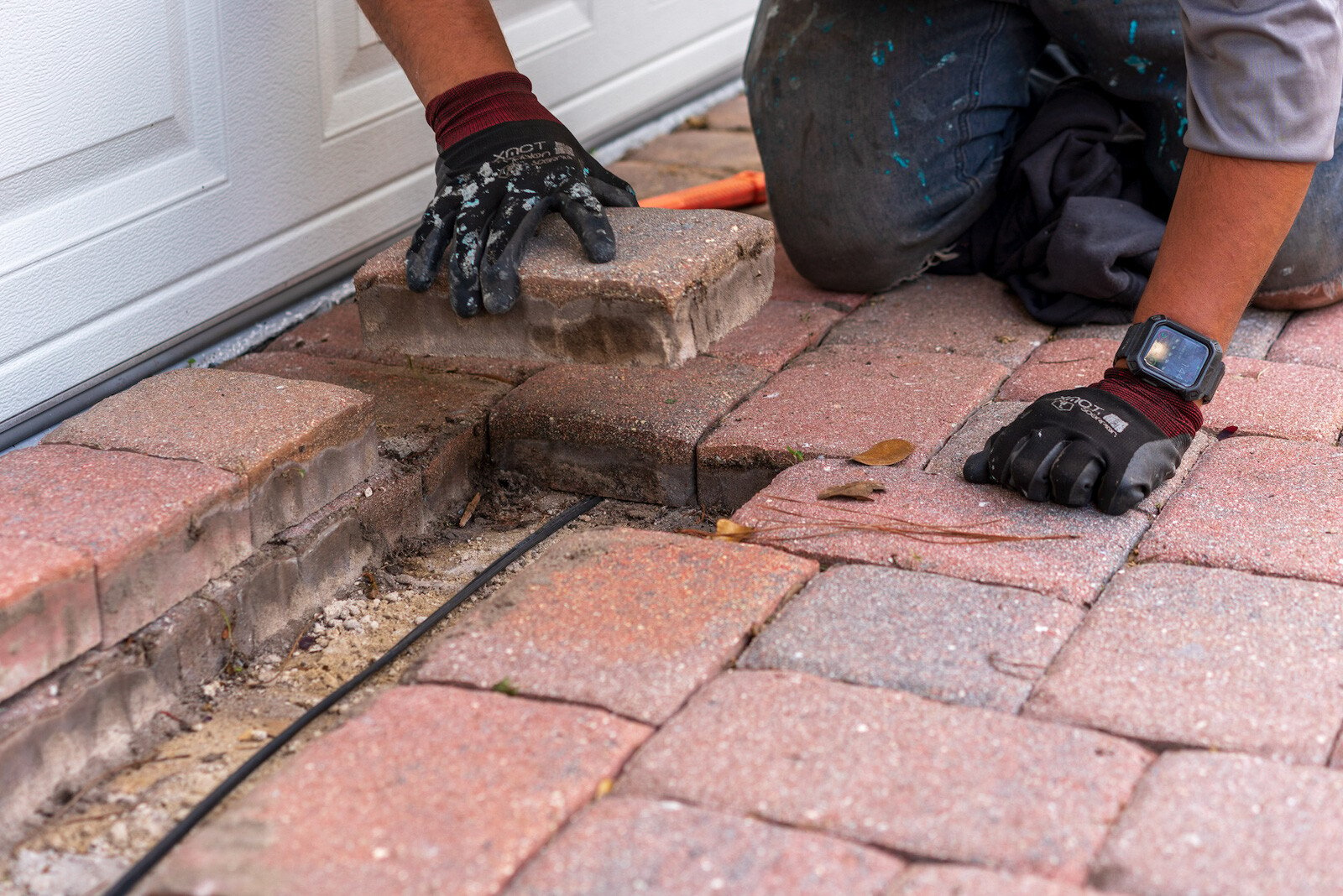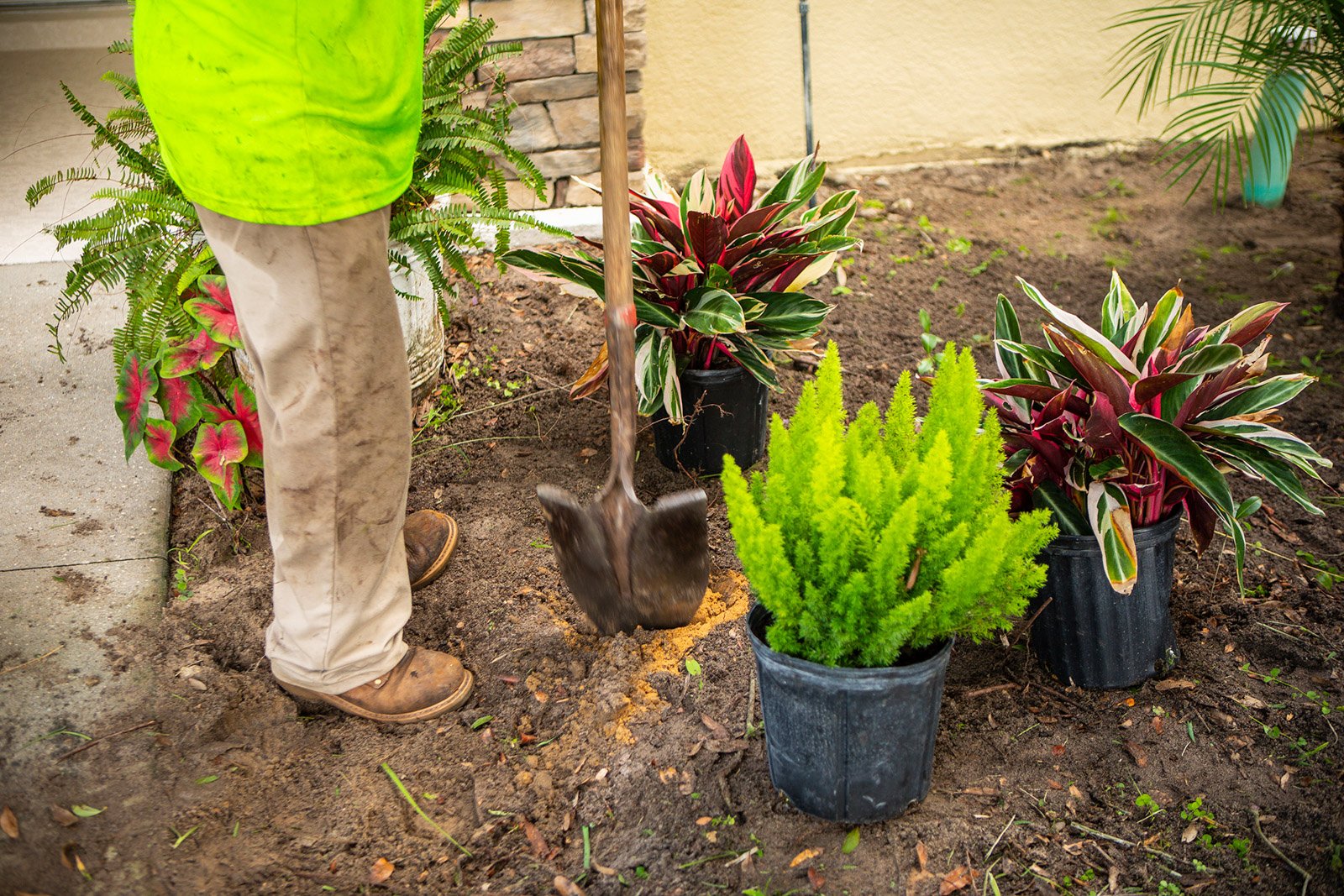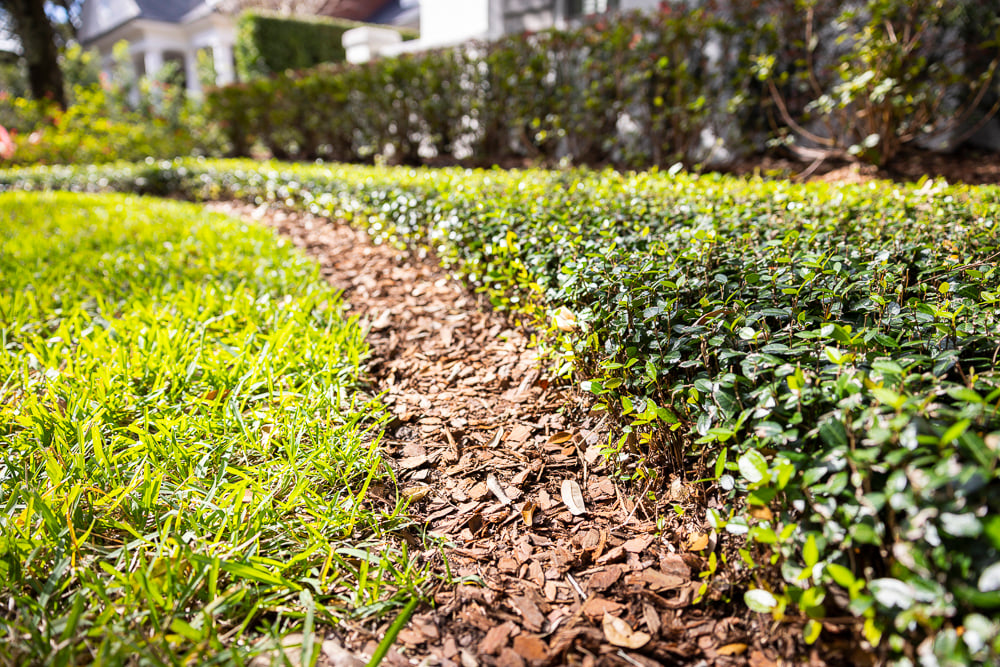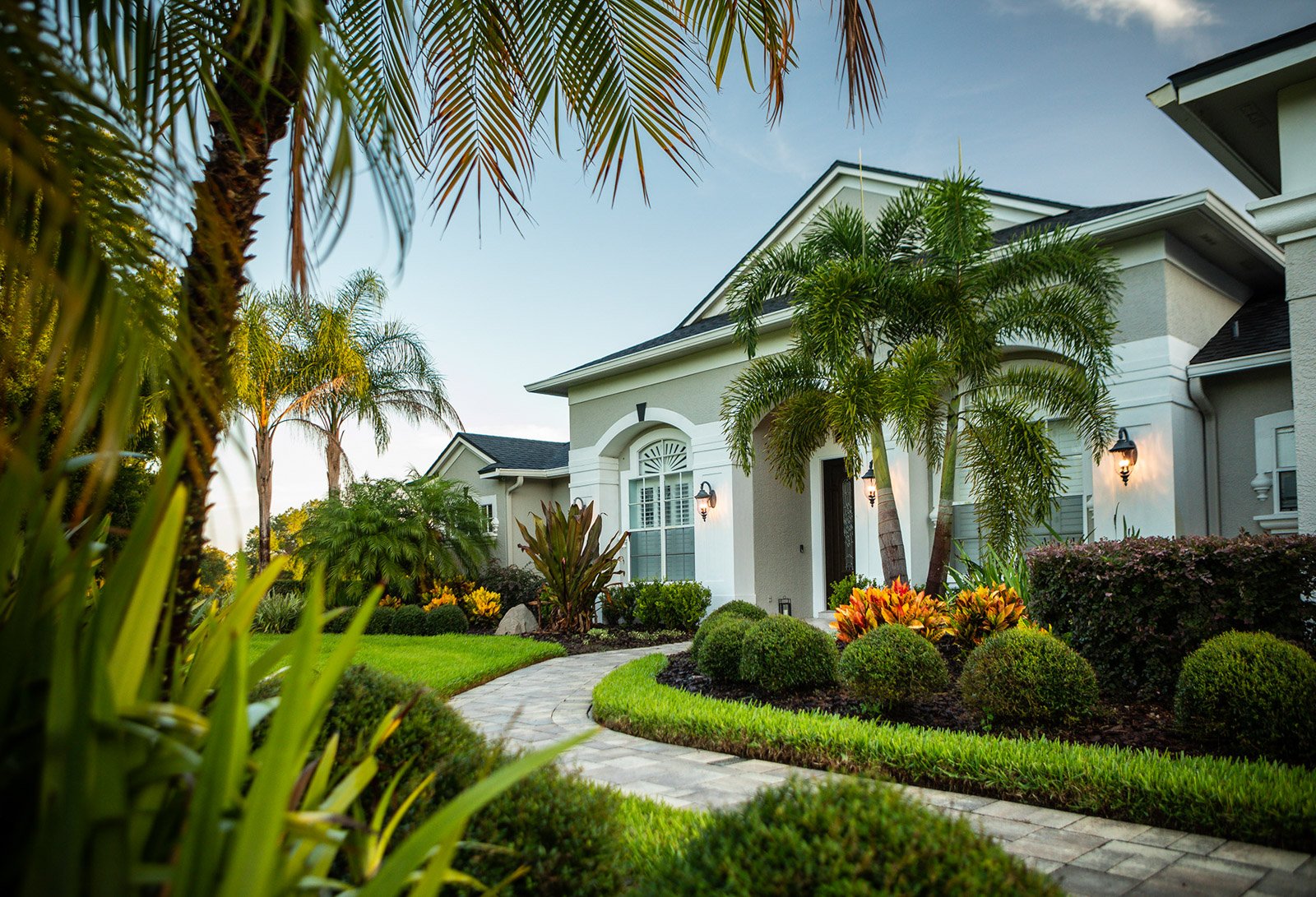“Beauty” and “drainage” don’t often appear in the same sentence, but a rain garden can be a beautiful fix if your property is soggy.
How effective are rain gardens in Central Florida? Very effective. Rain gardens are perfect for Central Florida’s crazy climate swings between rainy and dry spells. They tolerate drought, then happily soak up the deluge when the skies open up.
Let’s learn more about the benefits of rain gardens in Central Florida, including:
- First Up, What’s a Rain Garden?
- How to Tell if You Need a Rain Garden?
- Where Is the Best Place to Put a Rain Garden?
- Rain Garden Basics
- What Type of Plants Thrive in a Central Florida Rain Garden?
- When a Rain Garden Isn’t Enough
First Up, What’s a Rain Garden?
A rain garden is a shallow depression planted with deep-rooted native plants and grasses. It encourages excess water to soak slowly into the ground instead of pooling up and causing problems.
Rain gardens are designed to temporarily hold and soak up rainwater runoff from your roof, driveway, patio or lawn.
Why does that matter? In addition to keeping your property from being too wet and soggy, Central Florida rain gardens are super helpful for the environment. While adding beauty and interest to your yard, these gardens remove chemicals and sediment from rainwater runoff.

Every time it rains, water runs off hard surfaces like roofs and hardscapes, collecting bits of dirt, fertilizer, chemicals, oil and bacteria along the way. This polluted water then enters storm drains untreated and flows directly to nearby streams and ponds.
Rain garden plants collect that rainwater runoff, allowing the water to be filtered by vegetation and percolate into the soil.
Don’t mistake a rain garden for a water garden. Your rain garden will be dry most of the time. It’s designed to hold water only during and following rainfall. Then, the water will drain within 12-48 hours, so you don’t need to worry about standing water offering a breeding ground for mosquitoes.
How to Tell if You Need a Rain Garden?
You probably need some yard drainage if you live in a newer Orlando neighborhood.
Yard drainage in Orlando is a continuing problem as the city grows. Since all the dry areas have already been developed, nearly all the houses in new neighborhoods have drainage problems. The already wet ground can’t absorb extra water.

New homes also often have poor soil, so water doesn’t seep in as well as it should.
How can you tell?
- Puddles don’t evaporate
- Your grass stays saturated long after the rain stops
- Water pools on your driveway, patios, or sidewalk after you receive rainfall
- Excess water can damage your building’s foundation, erode and crack sidewalks, driveways and retaining walls.
Where Is the Best Place to Put a Rain Garden?
Plant a rain garden in a low-lying area of your yard, or near a water runoff source like a downspout, roof, or driveway.
Moving rain gardens away from your home and into low-lying areas ensures water soaks into the garden rather than hanging around on your property.
Rain Garden Basics
Here are a few tips for Central Florida rain garden planning:
Rain gardens in Central Florida are typically 4–8 inches deep. Deeper gardens can hold water too long, creating a breeding ground for mosquitoes.

Choose rain garden plants that tolerate both water and drought. (Keep reading for some great plant choices.)
Sandy soil will drain faster than clay.
Arrange rain garden plants that need the most water in the middle, and plant those that need less water along the edges of your rain garden.
What Type of Plants Thrive in a Central Florida Rain Garden?
Rain garden plants should be able to tolerate wet roots for short periods, usually 24 to 48 hours. But they should also be drought-tolerant for the dry times between rains.
Native plants are great choices for Orlando rain gardens. They’re used to the alternating rainy and dry periods here. Bonus: Native plants don’t need fertilizer, and maintenance is minimal after the first year.
Here’s a look at some great plants for Orlando rain garden design:
Muhly Grass
There are several types of muhly grass, but the real show-stopper is pink muhly, which explodes in spectacular, soft, fuzzy pink flowers in the fall that glow in the sunlight.
Known for its extreme drought tolerance, growing muhly grass is easy and requires little maintenance or upkeep, making it perfect for a Central Florida rain garden design.
Not a fan of pink? There’s also a white variety of muhly grass called ‘White Cloud’ with billowing white plumes.
Milkweed
Florida is home to more than 20 species of milkweed, and almost all of them are native Florida plants that are great for Orlando's rain garden construction.
Bonus: milkweed is a butterfly magnet. It’s the required host plant for caterpillars of the monarch butterfly, so it plays a critical role in the monarch’s life cycle.
Native milkweeds are also crucial to other important pollinators, including bumble bees.
Coontie
Coontie is happy in flooding and drought conditions, making it a top choice for Orlando rain gardens. These primitive plants look like small ferns, about one to three feet tall, with stiff, glossy, featherlike leaves. They’ve been around since dinosaurs roamed, so they’re a pretty safe bet for your rain garden planning.
Fakahatchee Grass
This native’s tall, green, grass-like foliage rises upright to form clumps between 4 and 6 feet tall and wide, offering great texture to your Central Florida rain garden.
Walter’s Viburnum
Another native, this shrub offers masses of small white flowers in the spring, attracting butterflies. Its fall fruit attracts birds and other wildlife. It's also a favorite nesting site for cardinals and other songbirds.
Cinnamon Fern
Cinnamon ferns are naturally found in Florida wet woodlands, stream banks, and other moist areas, so they’re perfectly home in Orlando rain gardens, where water collects. Their massive fronds are impressive in the rain garden, and meanwhile, the fern's extensive root system is complicated at work underground absorbing and filtering excess water.
Cardinal Flower
This stunning red perennial thrives in Central Florida rain gardens and is a hummingbird magnet—beauty, times two.
Blue Flag Iris
This native iris adds real beauty to Central Florida rain gardens with delicate blue or violet flowers.

When a Rain Garden Isn’t Enough
If you have a serious drainage problem, you might need more drainage than a rain garden provides.
Several landscape drainage heavy hitters are ready to step up:
Collection Boxes
Collection boxes, also called catch basins, are a Central Florida yard drainage staple.
It’s a 12-inch-square box with a grate on top and a drainage pipe that slopes away from the basin.
Placed in the ground at a low point on your property or wherever drainage is a problem, they work simply — water and debris enter the box through the grate. Solids settle to the bottom while water drains out of the pipe and is diverted to the street storm drains.
French Drains
A French drain is a gravel-filled trench with a perforated pipe inside.

Typically installed next to your home’s foundation, it uses gravity to divert your yard’s excess water. Water flows into the trench, soaks down through the gravel and into the pipe, which diverts it away from your yard.
They’re longer than a collection box, designed to collect water over the entire length of your house if needed, instead of in just one particular spot.
NDS EZ-Drain
An alternative to the French drain, the NDS EZ-Drain is installed without gravel, saving time and money.
EZ-Drain bundles consist of fabric, lightweight gravel substitute, and pipe. They’re like an entire yard drainage system bundled neatly together.
It halts installation time by eliminating the need to transport, shovel, and move heavy gravel.
Ready for a Central Florida Rain Garden? Trust Ground Source
Is your lawn too squishy? Are your socks wet?
Rain gardens in Orlando and Central Florida can be great solutions. They drain excess water and add curb appeal and beauty to your yard.
Need a heftier solution? We can help.
We’re yard drainage experts, and we’re with you every step of the way to figure out the best drainage plan of attack for your Central Florida yard. Sod, irrigation, landscape design: let us transform your yard from an embarrassing eyesore to a place you spend every spare minute.
Are you ready to enjoy the vibrant, impressive yard you've always wanted? Request a quote today! We’ll help you review your options and then transform your property.
Image Sources | Rain Garden, Rain Garden 2, Rain Garden 3







